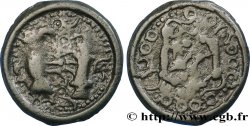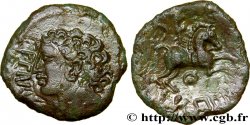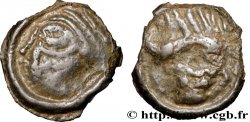bga_970459 - GALLIA BELGICA - MELDI (Area of Meaux) Potin au sanglier et au bucrane
150.00 €(Approx. 174.00$ | 130.50£)
Quantity
Add to your cart

Type : Potin au sanglier et au bucrane
Date: Ier siècle avant J.-C.
Metal : potin
Diameter : 17 mm
Orientation dies : 11 h.
Weight : 3,27 g.
Rarity : R2
Coments on the condition:
Flan épais et centré. D’agréables reliefs. Patine vert-gris
Obverse
Obverse legend : ANÉPIGRAPHE.
Obverse description : Tête à gauche, l'œil bien marqué, les cheveux en trois mèches parallèles dont l'une retombe devant l'œil.
Reverse
Reverse legend : ANÉPIGRAPHE.
Reverse description : Sanglier à gauche, la queue marquée par un petit annelet ; entre les pattes, un bucrane.
Commentary
Ce très rare potin semble manquer à tous les musées publiés (sauf la BN) consultés y compris au "Catalogue de monnaies gauloises du British Museum et d'autres collections britanniques" par Derek Allen. S. Scheers dans son inventaire ne reprenait que les trois exemplaires conservés à la BN et illustre dans son Traité le même exemplaire que celui qui fut gravé par Dardel au XIXe siècle pour illustrer le LA TOUR. L'attribution proposée serait entre les Meldes et les Bellovaques.
This very rare potin seems to be missing from all the published museums (except the BN) consulted including the \\\"Catalogue of Gallic coins in the British Museum and other British collections\\\" by Derek Allen. S. Scheers in his inventory only included the three examples kept at the BN and illustrates in his Treatise the same example as the one engraved by Dardel in the 19th century to illustrate the LA TOUR. The proposed attribution would be between the Meldi and the Bellovaci
This very rare potin seems to be missing from all the published museums (except the BN) consulted including the \\\"Catalogue of Gallic coins in the British Museum and other British collections\\\" by Derek Allen. S. Scheers in his inventory only included the three examples kept at the BN and illustrates in his Treatise the same example as the one engraved by Dardel in the 19th century to illustrate the LA TOUR. The proposed attribution would be between the Meldi and the Bellovaci








 Report a mistake
Report a mistake Print the page
Print the page Share my selection
Share my selection Ask a question
Ask a question Consign / sell
Consign / sell
 Full data
Full data










